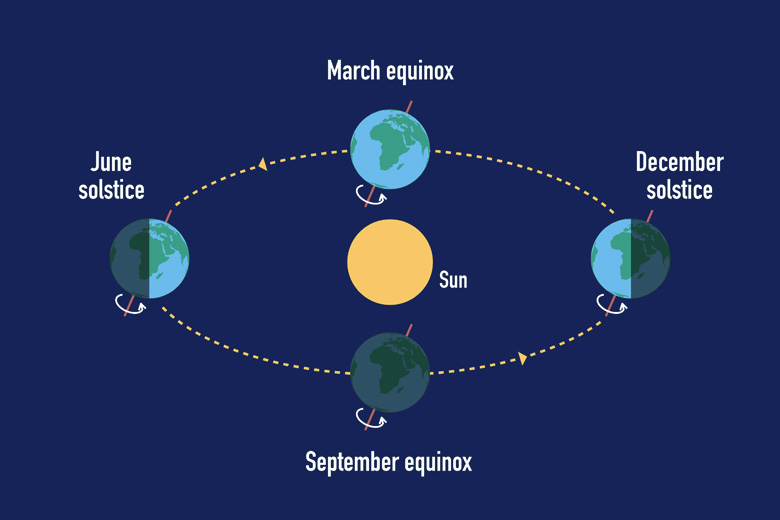UK seasons
The certainty of the UK's seasons is at the heart of life on the British Isles. Whether loved or loathed, our changing seasons is a constant that we all expect and accept. But do you know why we have distinct seasons, including their associated weather, or what causes them?

In this, your ultimate guide to the UK's seasonal weather, we look at these questions and more as we uncover what lies behind the springs, summers, autumns and winters that we anticipate and know so well.
- What creates the seasons?
- What are the meteorological seasons?
- What is the solstice?
- What is the equinox?
What creates the seasons?
Earth is a fascinating planet. It not only spins on its axis once every 24 hours to give us a day but simultaneously orbits the sun once every 365 days (well, 365.25 to be precise) to mark the passage of a year. But what gives us our seasons? Why is it not summer everywhere in the world at one time and winter everywhere six months later?
The answer to this question lies in the simple fact that the earth's axis is tilted from the plane of its orbit around the sun by 23.5°. This means the energy we receive from the sun is not evenly distributed over the planet's surface. Different parts of the earth get more or less sun depending on where the earth is in its orbit around the sun.
At one point in that orbit, the North Pole will face more towards the sun bringing summer to the northern hemisphere but six months later, at the opposite extent of its orbit, the same 23.5° tilt will favour the South Pole facing more towards the sun, at which time it will be winter in the northern hemisphere.
Both the tilt and the orbital plane are fixed. The only thing that changes is the earth's position on its passage around the sun. What is also true is that when one hemisphere basks in summer the other experiences winter.
Weak sun in winter has everything to do with the tilt and nothing to do with distance from the sun. In fact, somewhat ironically, the earth is three million miles closer to the sun during the northern hemisphere winter than it is in summer.
The four seasons
As the earth orbits the sun, we move day-by-day through each season. If we use the northern hemisphere as an example, our seasons can be broken down as follows:
- Spring - when more of the northern hemisphere than the southern hemisphere is exposed to the sun, days in the northern hemisphere become longer and temperatures start to rise
- Summer - when the northern hemisphere's exposure to the sun reaches its maximum extent, days in the northern hemisphere are at their longest and temperatures rise
- Autumn - when more of the southern hemisphere than the northern hemisphere is exposed to the sun, days in the northern hemisphere become shorter and temperatures start to fall
- Winter - when the northern hemisphere's exposure to the sun reaches its minimum extent, days in the northern hemisphere are at their shortest and temperatures fall
What are the meteorological seasons?
You may sometimes hear the term 'meteorological' spring, summer, autumn and winter referred to especially when listening to a weather forecast.
These differ from the dates when the astronomical equinoxes and solstices occur by a few weeks and coincide with the first day of the months in which the astronomical seasons start.
They have not been assigned like this just to conveniently align our seasons to the calendar months of the year, however.
There is a real benefit in describing the seasons along these lines because it is generally true, especially in the temperate regions of the northern hemisphere, that the coldest time of year is from the beginning of December to the end of February and the warmest time from the beginning of June to the end of August.
Seasonal statistics are calculated on 'meteorological' seasons, not astronomical ones.
| Months | Spring | Summer | Autumn | Winter |
|---|---|---|---|---|
| January | ✓ | |||
| February | ✓ | |||
| March | ✓ | |||
| April | ✓ | |||
| May | ✓ | |||
| June | ✓ | |||
| July | ✓ | |||
| August | ✓ | |||
| September | ✓ | |||
| October | ✓ | |||
| November | ✓ | |||
| December | ✓ |
What is the solstice?
Did you know that there are two solstices in every year? There's the summer (or June) solstice and the winter (or December) solstice.
The summer solstice is when the northern hemisphere is most fully tilted towards the sun, creating the longest day and shortest night of the year. This typically occurs around 21 or 22 of June each year when the sun appears directly overhead at the Tropic of Cancer 23.5° north of the equator.
Meanwhile, the winter solstice marks the earth's journey at the opposing point of the earth's orbit around the sun, when the northern hemisphere is most fully tilted away from the sun, serving up the shortest day and longest night.
This typically occurs just before Christmas around 21 December when the sun appears directly overhead at the Tropic of Capricorn 23.5° south of the equator.

What is the equinox?
As with the solstices, there are two equinoxes. They represent the halfway points between each solstice, with the spring (or March or vernal) equinox, occurring on 20 March and the autumn (or September) equinox appearing around the 22 or 23 September.
Unlike the summer and winter solstices, both the spring and autumn equinoxes have days and nights of equal length marking the midpoint in the earth's orbit around the sun between the two solstices. They hail the arrival of spring and autumn respectively.
Upcoming solstices & equinoxes
| Year | Spring equinox | Summer solstice | Autumn equinox | Winter solstice |
|---|---|---|---|---|
| 2023 | 20 March | 21 June | 23 September | 22 December |
| 2024 | 19 March | 20 June | 22 September | 21 December |
Find out more: visit our comprehensive guide to the UK's weather before planning your perfect holiday in the UK.
Be inspired
Get your weekly fix of holiday inspiration from some of the world's best travel writers plus save on your next trip with the latest exclusive offers
We promise not to share your details
Explore holiday destinations
- Beach holidays
- City breaks
- Family holidays
- Half term holidays
- Spring holidays
- Summer holidays
- Autumn holidays
- Winter sun holidays
- Honeymoons
- Coolcations
- Compare places
- Ski resorts
Save with latest deals & discounts
- Holiday offers
- Top travel brands
- Airlines & flights
- Discount hotels
- TUI
- Jet2holidays
- Neilson
- Marella Cruises
- Pierre & Vacances
- Caledonian Travel
- Club Med
- Boxing Day sales
Airport parking
- Manchester Airport
- Stansted Airport
- Bristol Airport
- Luton Airport
- Birmingham Airport
- Edinburgh Airport
- Gatwick Airport
- Glasgow Airport
- Newcastle Airport
Airport lounges
- Manchester Airport
- Birmingham Airport
- Bristol Airport
- Edinburgh Airport
- Glasgow Airport
- Heathrow Airport
- Newcastle Airport
- Stansted Airport
- Gatwick Airport




